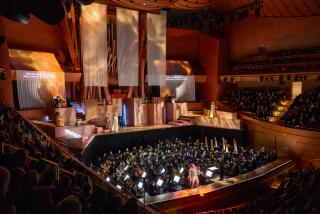End of Century a Perfect Time for Adept Tomlin to Resume Her ‘Search’
- Share via
The multitudes who loved Lily Tomlin in Jane Wagner’s “The Search for Signs of Intelligent Life in the Universe” in the ‘80s have searched for signs that the show might return. After a long L.A. run at the Doolittle Theatre in 1986-87, “Search” did show up briefly in Beverly Hills in 1990. It was then turned into a movie that didn’t garner the same acclaim as the stage production.
The end of 1999, however, is a perfect time for a revival. As we enter the 21st century, everyone is trying to think deep thoughts about what it all means. Certainly Trudy, the bag lady who narrates “Search” and relates her experiences observing humanity with a group of space aliens, is as qualified as anyone else.
Trudy and the other people Tomlin channels in her show returned for two performances at the Orange County Performing Arts Center and one in San Diego over the weekend, and here’s hoping that a longer visit is in the works.
*
As a performer, Tomlin is still in her prime. She seemed no less limber on Saturday than she did 14 years ago. This dexterity, and sheer stamina, are critical qualities for a performance that requires switching back and forth among more than a dozen characters--from an angry teenager to a hooker to a bored socialite--for more than two hours. Tomlin’s timing is so acute that she can whip up a giant laugh one minute and command intense silence the next.
Some might have expected Jane Wagner’s text to have dated. It’s true that many of the cultural references are best known by those who were already adults in the ‘70s and ‘80s. However, some of the most topical lines in the published script (and one character, Judy Beasley) have been cut. And a few ‘90s words have infiltrated the current script--Paul, a gym rat who’s one of the few male characters in the show, has a great line involving his genitals and a laptop. Bob, the holistic capitalist whom we meet through the adventures of his wife Lyn, is now described as an Internet-related businessman.
Generally, however, the text hasn’t been substantially altered, and the ‘70s and ‘80s names hardly make the material seem musty. For it’s the more fundamental, longer-term reflections that matter most in this show.
*
In the second-act saga of Lyn, for example, the bittersweetness of her evolution from young idealism to middle-aged compromise is an evergreen theme, regardless of the specific details of Lyn’s life. This segment remains a jaw-dropping exhibition of how one writer and one performer can conjure up two decades and a half-dozen lives in just a few minutes. Watching it Saturday, I almost literally forgot that only one woman was on stage, so fully engaging was the panoramic story unfolding before me.
This effect is all the more astonishing because the immediately preceding segment, involving two hookers who tell stories to a writer, is the least involving of the show. Its effect is diminished not by old-fashioned references, but by a slight lack of clarity in the writing and by the fact that--unlike the other characters--the hookers are telling other people’s stories more than their own.
G. Thomas Clark’s virtuoso sound design was in fine form Saturday in Orange County. Effects as well as the words were crystal clear. Still, if Tomlin brings the show back to L.A., she should do it in a much smaller theater. With a performance this rich, you want to see every facial twitch, which was impossible from many of the far-away seats in Costa Mesa.
More to Read
The biggest entertainment stories
Get our big stories about Hollywood, film, television, music, arts, culture and more right in your inbox as soon as they publish.
You may occasionally receive promotional content from the Los Angeles Times.










